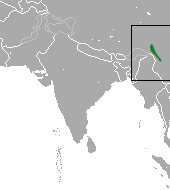Black blunt nose
| Black blunt nose | ||||||||||||
|---|---|---|---|---|---|---|---|---|---|---|---|---|

Black blunt nose ( Rhinopithecus habeni ) |
||||||||||||
| Systematics | ||||||||||||
|
||||||||||||
| Scientific name | ||||||||||||
| Rhinopithecus offers | ||||||||||||
| Milne-Edwards , 1897 |
The black snub nose ( Rhinopithecus bitteni ) is a species of primate from the group of the Schlankaffen (Presbytini). It lives in mountain forests in southern China and is the highest primate species living above the sea after humans.
features
The fur of the black snub noses is relatively long as an adaptation to the cool habitat; it is predominantly black or dark brown in color on the back, on the limbs and on the top of the head. The buttocks, the neck, the crooks of the arms and the stomach are whitish. The muzzle region is hairless and pink in color, the area around the eyes is light yellow or light green. Like all snub- nosed monkeys , they are characterized by their greatly reduced nose, the holes of which point forward. Male animals also have a tuft of hair, elongated hair in the shoulder and upper arm area and larger canine teeth. There is also a clear gender dimorphism in terms of weight : males, at 15 to 17 kilograms, are significantly heavier than females, which reach 9 to 12 kilograms.
distribution and habitat
Black snub noses are endemic to China , where they are found in northwestern Yunnan and southeastern Tibet . Their habitat are coniferous and mixed forests between 3000 and 4500 meters above sea level. In their area of distribution, temperatures drop below 0 ° C in several months of the year and snowfalls are frequent. These primates are among the most cold-tolerant primates ever.
Lifestyle and diet
Black snub noses, like all Old World monkeys, are diurnal, the high points of activity time are in the early morning and late afternoon. They rested at noon. They can be found both in the trees and on the ground, so they are semi-terrestrial to a greater extent than most other slender monkeys.
They live together in large groups of up to 200 animals. These associations consist of individual harem groups, which are composed of a male, several females and their offspring. The associations repeatedly divide into these individual groups and come back together again (fission-fusion model), which may depend on the food supply and external disturbances. The territories of the groups can be very large (up to 46 km²) depending on the habitat. In winter these animals migrate to lower regions.
Black snub noses are herbivores. Young leaves and lichens are likely to make up the main component of their diet , especially beard lichens and lichens of the genus Bryoria . Their menu is supplemented by tree bark and - if available - also fruit and nuts.
Reproduction
The mating of the black snub noses takes place in August and September, in March or April the female then usually gives birth to a single young. Newborns have a completely white coat, which only takes on the typical adult coloring over the course of several years. Males are sexually mature at 5 to 6 years and females at 4 to 5 years.
threat
The western world only became aware of this primate species in the 1890s. After that there were no observations for decades and until it was rediscovered in the 1960s, it was considered extinct in isolated cases. Their main threat today is the loss of their habitat through deforestation, with hunting to a lesser extent. Their range has been split up into several small regions. Estimates of the total population amount to around 1500 animals, the IUCN lists the species as endangered .
literature
- Thomas Geissmann : Comparative Primatology. Springer-Verlag, Berlin et al. 2003, ISBN 3-540-43645-6 .
- Lee E Harding; Lian-Xian Han: Rhinopithecus habeni (Primates: Cercopithecidae). In: Mammalian Species. Volume 50, No. 969, October 5, 2018, pp. 148-165, doi : 10.1093 / mspecies / sey016 .
Web links
- Rhinopithecus bieti in the endangered Red List species the IUCN 2006. Posted by: A. Eudey & Members of the Primate Specialist Group, 2000. Retrieved on April 4 of 2008.
- Information on Theprimata.com (English)
- Information at Animalinfo.org
- Photos and videos at arkive.org
